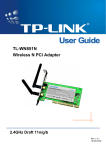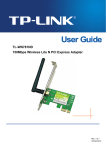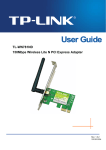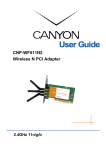Download TP-LINK 54Mbps Wireless PCI Adapter
Transcript
TL-WN353G 54M Wireless PCI Adapter Rev: 1.0.1 1910010045 COPYRIGHT & TRADEMARKS Specifications are subject to change without notice. ® is a registered trademark of TP-LINK TECHNOLOGIES CO., LTD. Other brands and product names are trademarks or registered trademarks of their respective holders. No part of the specifications may be reproduced in any form or by any means or used to make any derivative such as translation, transformation, or adaptation without permission from TP-LINK TECHNOLOGIES CO., LTD. Copyright © 2008 TP-LINK TECHNOLOGIES CO., LTD. All rights reserved. http://www.tp-link.com FCC STATEMENT This equipment has been tested and found to comply with the limits for a class B digital device, pursuant to part 15 of the FCC Rules. These limits are designed to provide reasonable protection against harmful interference in a residential installation. This equipment generates, uses and can radiate radio frequency energy and, if not installed and used in accordance with the instructions, may cause harmful interference to radio communications. However, there is no guarantee that interference will not occur in a particular installation. If this equipment does cause harmful interference to radio or television reception, which can be determined by turning the equipment off and on, the user is encouraged to try to correct the interference by one or more of the following measures: ¾ Reorient or relocate the receiving antenna. ¾ Increase the separation between the equipment and receiver. ¾ Connect the equipment into an outlet on a circuit different from that to which the receiver is connected. ¾ Consult the dealer or an experienced radio/TV technician for help. This device complies with Part 15 of the FCC Rules. Operation is subject to the following two conditions: (1) This device may not cause harmful interference. (2) This device must accept any interference received, including interference that may cause undesired operation. Changes or modifications to this unit not expressly approved by the party responsible for compliance could void the user's authority to operate the equipment. FCC RF Radiation Exposure Statement: This equipment complies with FCC RF radiation exposure limits set forth for an uncontrolled environment. This device and its antenna must not be co-located or operating in conjunction with any other antenna or transmitter. “To comply with FCC RF exposure compliance requirements, the antenna used for this transmitter must be installed to provide a separation distance of at least 20 cm from all persons and must not be co-located or operating in conjunction with any other antenna or transmitter”. CE Mark Warning This is a class B product. In a domestic environment, this product may cause radio interference, in which case the user may be required to take adequate measures. National Restrictions 2400.0-2483.5 MHz Country Restriction General authorization required for outdoor use and Bulgaria France Reason/remark public service Outdoor use limited to 10 Military Radiolocation use. Refarming of the 2.4 GHz band mW e.i.r.p. within the band has been ongoing in recent years to allow current relaxed 2454-2483.5 MHz regulation. Full implementation planned 2012 If used outside of own premises, general authorization is Italy required Luxembourg None Norway Implemented Russian Federation Note: It not used outdoors in France. General authorization required for network and service supply(not for spectrum) This subsection does not apply for the geographical area within a radius of 20 km from the centre of Ny-Ålesund Only for indoor applications CONTENTS Package Contents .................................................................................................... 1 Chapter 1 Introduction ......................................................................................... 1 1.1 Overview of the Product ........................................................................................ 1 1.2 Features ................................................................................................................ 1 1.3 LED Status ............................................................................................................ 1 Chapter 2 Installation Guide ................................................................................ 2 2.1 Hardware Installation............................................................................................. 2 2.2 Software Installation .............................................................................................. 2 2.2.1 Overview ................................................................................................ 2 2.2.2 Software Installation for Windows XP .................................................... 2 2.2.3 Software Installation for Windows Vista ................................................. 5 Chapter 3 Configuration....................................................................................... 9 3.1 Set Wizard............................................................................................................. 9 3.2 General Status .................................................................................................... 11 3.3 Profile Management ............................................................................................ 12 3.3.1 Add or Edit a Configuration Profile ....................................................... 13 3.3.2 Remove a configuration profile............................................................. 18 3.3.3 Duplicate a configuration file ................................................................ 19 3.3.4 Set default configuration profile............................................................ 19 3.4 Available Network................................................................................................ 19 3.5 Advanced ............................................................................................................ 20 3.6 Status .................................................................................................................. 21 3.7 Statistics .............................................................................................................. 22 3.8 Wi-Fi Protect Setup ............................................................................................. 23 3.8.1 PIN ....................................................................................................... 24 3.8.2 Question-Answer Method..................................................................... 26 Appendix A: Specifications................................................................................... 27 Appendix B: Glossary............................................................................................ 29 Package Contents The following items should be found in your package: ¾ ¾ ¾ One TL-WN353G 54M Wireless PCI Adapter Quick Installation Guide One Resource CD for TL-WN353G, including: • • • TP-LINK Wireless Utility and Drivers User Guide Other Helpful Information ) Note: If any of the listed contents are damaged or missing, please contact the retailer from whom you purchased the TL-WN353G 54M Wireless PCI Adapter for assistance. Conventions: The ‘Adapter’ and ‘PCI Adapter’ mentioned in this User guide both stand for TL-WN353G 54M Wireless PCI Adapter without any explanations. 1 TL-WN353G 54M Wireless PCI Adapter User Guide Chapter 1 Introduction Thank you for choosing the TL-WN353G 54M Wireless PCI Adapter! 1.1 Overview of the Product The adapter will provide you the flexibility to install your PC in the most convenient location available, without the cost of running network cables. The Adapter's auto-sensing capability allows high packet transfer rate of up to 54Mbps for maximum throughput, or dynamic range shifting to lower speeds due to distance or operating limitations in an environment with a lot of electromagnetic interference. It can also interoperate with all 11Mbps wireless (802.11b) products. Your wireless communications are protected by up to 152-bit WEP and WPA encryption for high security. 1.2 Features ¾ Complies with IEEE802.11g, IEEE802.11b standards ¾ Supports WPA/WPA2 data security, IEEE802.1x authentication, TKIP/AES encryption, 64/128/152-bit WEP encryption ¾ Supports 54/48/36/24/18/12/9/6Mbps or 11/5.5/2/1Mbps wireless LAN data transfer rates ¾ Provides 32-bit PCI interface ¾ Supports Ad-Hoc and Infrastructure modes ¾ Supports roaming between access points when configured in Infrastructure mode ¾ Ease to configure and provides monitoring information ¾ Supports Windows 98, ME, 2000, 2003, XP, Vista, XP64 ¾ Supports fixed antenna 1.3 LED Status Status LED Indications Working Status The adapter is in an electricity saving status or Status Green Intermittently the adapter is already connected but is not transmitting or receiving data. Status Green On The adapter is on wake up status. Status Green Flashing The adapter is transmitting and receiving data. 1 TL-WN353G 54M Wireless PCI Adapter User Guide Chapter 2 Installation Guide 2.1 Hardware Installation To install the Adapter, follow these steps listed below: 1. Turn off your desktop PC and disconnect the power. 2. Remove your PC case and locate an available PCI slot on the mianboard. Remove the metal slot cover on the back of the PC. Check with your computer manufacturer for instructions if needed. 3. Slide the PCI Adapter into the PCI slot. Make sure that all of its pins are touching the slot's contacts. Once the adapter is firmly in place, secure its fastening tab to your PC's chassis with a mounting screw. Then, close your PC case. 4. 2.2 Reconnect your PC’s power and turn on your desktop PC. Software Installation 2.2.1 Overview The Adapter’s Setup Wizard will guide you through the Installation procedure for Windows XP and Vista. The Setup Wizard will install the TP-LINK Wireless Utility and drivers. When you install the hardware before installing the software, the system will prompt “Found New Hardware Wizard”, click Cancel, and run the Setup Wizard program on the CD-ROM. The Setup steps for Windows operation Systems are very similar. The User guide takes the Windows XP for example to explain the installation. 2.2.2 Software Installation for Windows XP Step 1: Insert the Resource CD into your CD-ROM drive, and open the folder with the same name as your product. Then double-click Setup.exe in the proper folder to start the installation, and Figure 2-1 will appear. Click Cancel to end the installation in the screen. Otherwise, the installation will continue. 2 TL-WN353G 54M Wireless PCI Adapter User Guide Figure 2-1 Step 2: Click Next in the screen below (shown in Figure 2-2) to continue, you can click Cancel to end the installation. Figure 2-2 Step 3: After that, the next screen displays, select Install to continue. 3 TL-WN353G 54M Wireless PCI Adapter User Guide Figure 2-3 Step 4: In the next screen, the files will be copied as the next screen shown (shown in Figure 2-4). To end the Installation, click Cancel. Figure 2-4 ) Note: During the installation, the system will warn about Windows Logo testing, please click Continue Anyway to continue the installation. 4 TL-WN353G 54M Wireless PCI Adapter User Guide Figure 2-5 Step 5: Click the Finish button to complete. Figure 2-6 2.2.3 Software Installation for Windows Vista 1. Insert the Resource CD into your CD-ROM drive, and open the folder with the same name as your product. Then double-click Setup.exe in the proper folder according to your operating system to start the installation. And then Figure 2-7 will appear; Click Cancel to end the installation in the screen. Otherwise, the installation will continue. 5 TL-WN353G 54M Wireless PCI Adapter User Guide Figure 2-7 2. Click Next in the screen below (shown in Figure 2-12) to continue, you can click Cancel to end the installation. Figure 2-8 3. After that, the files will be copied as the next screen shown (shown in Figure 2-13). To end the Installation, click Cancel. 6 TL-WN353G 54M Wireless PCI Adapter User Guide Figure 2-9 ) Note: During the installation, the system will warn about Windows Security testing, please click “Install this driver software anyway” to continue the installation. Figure 2-10 4. Click the Finish button to complete. 7 TL-WN353G 54M Wireless PCI Adapter User Guide Figure 2-11 8 TL-WN353G 54M Wireless PCI Adapter User Guide Chapter 3 Configuration TP-LINK Wireless PCI Adapter TL-WN353G can be configured by TP-LINK Wireless Utility. This chapter describes how to configure your TP-LINK Wireless PCI Adapter for wireless connectivity on your Wireless Local Area Network (WLAN) and use the data security encryption features. After Installing the Adapter, the Adapter’s tray icon will appear in your system tray. It appears at the bottom of the screen, and shows the signal strength using color and the received signal strength indication (RSSI). If the icon is gray, there is no connection. If the icon is red, there is poor signal strength and the RSSI is less than 5dB. If the icon is yellow, there is poor signal strength and the RSSI is between 5dB and 10dB. If the icon is green, there is good signal strength and the RSSI is between 10dB and 20dB. If the icon is green, there is excellent signal strength and the RSSI is more than 20dB. Double-click the icon and the TP-LINK Wireless Utility will run. You can also run the utility by clicking the Start>Programs>TP-LINK>RTWCU>TP-LINK Wireless Utility. The utility provides integrated and easys tool to: ¾ Display current status information ¾ Edit and add configuration profiles ¾ Display current statistics information The sections below take Windows XP for example to introduce these above capabilities. 3.1 Set Wizard Choose the menu Set Wizard on the top of the utility screen; you can select the operation mode for the adapter (we select the infrastructure mode for example). Step 1: Select Station [infrastructure] (show in Figure 3-1). Then click Next. 9 TL-WN353G 54M Wireless PCI Adapter User Guide Figure 3-1 Step 2: Click Refresh button to update the wireless network (show in Figure 3-2). Then select the wireless network and click Next. Figure 3-2 Step 3: After that, select the network authentication and data encryption, click OK, and the adapter can connect the specific wireless network. 10 TL-WN353G 54M Wireless PCI Adapter User Guide Figure 3-3 ) Note: During the connection, if the screen prompts "Unsecured network", click OK to continue. 3.2 General Status Choose the tab General as shown in Figure 3-4, the left filed displays the type of the adapter, the right field displays the status about the connection, including Status, Speed, Type, SSID, Signal Strength, Link Quality and other IP information. 11 TL-WN353G 54M Wireless PCI Adapter User Guide Figure 3-4 ¾ Signal Strength - This shows the strength of the wireless signal. ¾ Link Quality - This shows the quality of the wireless connection. ¾ ReNew IP - Click the button to get the IP address from the AP. ¾ Show Tray Icon - Select the option to display the icon on the bottom of the desktop. Otherwise, you can see the two icons. ¾ Disable Adapter - If you select the option, the adapter can’t work. ¾ Radio Off - If you select the option, the wireless function will be ineffective. Click Close to close the screen. 3.3 Profile Management Click the tab Profile as shown in Figure 3-5 to add, remove, edit, duplicate or set default for a profile. 12 TL-WN353G 54M Wireless PCI Adapter User Guide Figure 3-5 3.3.1 Add or Edit a Configuration Profile Click the button Add or Edit (you should select an existed profile first to edit it) on the screen above, and you can configure the profile as shown in Figure 3-6. We add a new profile and configure it for example here. 13 TL-WN353G 54M Wireless PCI Adapter User Guide Figure 3-6 ¾ Profile Name - Please enter the Profile name which identifies the configuration profile. This name must be unique. Note that the profile names are not case-sensitive. ¾ Network Name (SSID) - Please enter the IEEE 802.11 wireless network name. This field has a maximum limit of 32 characters. ) Note: The Profile Name and Network Name are necessary for the profile, you must configure it. ¾ Channel - If you want to use the specific channel to connect to the wireless network, select the option “This is a computer-to-computer (ad-hoc) network; wireless access points are not used.” If you don't select the option, the system will search the available channel to connect. ¾ Wireless network security - This configure the security for the adapter. ) Note: You should configure the security for the adapter according with the wireless network that you want to connect. If the wireless network takes some security measure, you should configure the same security for the adapter accordingly. If the wireless network doesn’t take security measure, you don’t need to configure the security for the adapter. • Network Authentication - Select which mode the Wireless PCI Adapter uses to authenticate to an access point. These modes are: Open System, Shared key, WPA-PSK, WPA2-PSK, WPA 802.1X, WPA2 802.1X, and WEP 802.1X. • Data encryption - Select the corresponding data encryption for the authentication. These encryptions are: Disabled, WEP, TKIP and AES. 14 TL-WN353G 54M Wireless PCI Adapter User Guide ) Note: 1) Select different authentications and data encryptions, the security configuration is different. 2) When you select channel manually, the available network authentication are Open System, Shared key and WPA-None. 3) The RTWCU does not support WPA 802.1x authentication in Windows Vista, while the Windows Zero Config Tools may satisfy your need. ¾ • ASCII - Select this option, you can enter any ASCII characters to compose the password. • PASSPHRASE - Select this option, you can enter the characters from 0~9 to compose the password. • • Key Index - Select the index of the password. Network Key & Confirm network key - The fields configure the network key. The two should be the same. 802.1x configure - This configures the 802.1x security, it is available when you select the data encryption as WPA 802.1X, WPA2 802.1X or WEP 802.1X. 1. • EAP TYPE - Select the EAP type for the 802.1x configuration, the options are: GTC, TLS, LEAP, TTLS, PEAP. • Tunnel - Select the tunnel: MD5, GTC, TLS, and MSCHAP-V2. The option is necessary for the EAP type of TTLS and PEAP. • Username - Enter the username for authentication. The option is necessary for the EAP type of TTLS and PEAP. • • Identity - Enter the identity for the authentication. Password - Enter the password for the authentication. The option is necessary for the EAP type of LEAP, TTLS and PEAP. • Certificate - Select the certificate you apply. Open System authentication When you select the Open System as the authentication, the Disabled and WEP can be available for the data encryption. If you select Disabled, you don’t need to configure any passwords. If you select WEP, you can configure the password as follows. For example: If the wireless network takes Open System authentication, WEP data encryption, the password is 64bit with the value of 0123456789. The index is 1. 15 TL-WN353G 54M Wireless PCI Adapter User Guide Figure 3-7 Step 1: Select the “Open System” as the Network Authentication. Step 2: Select the “WEP” as Data encryption. Step 3: Select the type for the password and you can select the ASCII or PASSPHRASE. For ASCII, you can enter any characters in the keyboard; For PASSPHRASE, you can enter the characters from 0 to 9. Step 4: Select “64 Bits” as the Key Length, then enter “0123456789” as the password value. Step 5: Select the Key index “1”, and click the OK to save the configuration. 2. Shared Key authentication When you select the Shared Key as the authentication, the only available data encryption is WEP. ) Note: The configuration for Shared Key authentication and Open System are similar, you can refer to the Open System authentication to configure it. 3. WPA-PSK authentication When you select the WPA-PSK as the authentication, the available data encryptions are TKIP and AES. Please select the one according your need. For example: If the wireless network takes WPA-PSK authentication, TKIP data encryption, the network key is 0123456789. You can configure it for adapter as follows. 16 TL-WN353G 54M Wireless PCI Adapter User Guide Figure 3-8 Step 1: Select the “WPA-PSK” as the Network Authentication. Step 2: Select the “TKIP” as Data encryption. Step 3: Enter the Network key and confirm it. Step 4: Click the OK to save the configuration. 4. WAP2-PSK authentication When you select the WPA2-PSK as the authentication, the available data encryptions are TKIP and AES. Please select the one according your need. ) Note: The configuration for WPA2-PSK and WPA-PSK are similar, you can refer to WAP-PSK authentication to configure it. 5. WPA 802.1x When you select the WPA 802.1x as the authentication, the available data encryptions are TKIP and AES. For the authentication, you should configure the 802.1x security. Select the EAP Type and configure the corresponding options. 17 TL-WN353G 54M Wireless PCI Adapter User Guide Figure 3-9 ) Note: Select different EAP types, the configuration are different. 6. WPA2 802.1x When you select the WPA2 802.1x as the authentication, the available data encryptions are TKIP and AES. For the authentication, you should configure the 802.1x security. ) Note: The configuration for WPA2 802.1x and WPA 802.1x are similar, you can refer to WPA 802.1x authentication to configure it. 7. WEP 802.1x When you select the WEP 802.1x as the authentication, the only available data encryption is WEP. ) Note: The configuration for WEP 802.1x authentication and WPA 802.1x are similar, you can refer to WPA 802.1x authentication to configure it. 3.3.2 Remove a configuration profile Follow the steps below to delete a configuration profile. Step 1: Go to the Profile tab (shown in Figure 3-10). 18 TL-WN353G 54M Wireless PCI Adapter User Guide Step 2: Select the profile name in the Profiles List. Step 3: Click Remove. Figure 3-10 3.3.3 Duplicate a configuration file Follow the steps below to change the name of a configuration profile. Step 1: Go to the Profile tab (shown in Figure 3-10). Step 2: Select the profile name in the Profiles List. Step 3: Click Duplicate, and then enter the new name for the configuration profile. 3.3.4 Set default configuration profile Follow the steps below to select a configuration profile as default. Once the adapter wants to connect a wireless network, it will select the default profile to connect firstly. Step 1: Go to the Profile tab (shown in Figure 3-10). Step 2: Select the profile name in the Profiles List. Step 3: Click Set Default. 3.4 Available Network Click the tab Profile as shown in Figure 3-11 to view the wireless networks. You can follow the steps below to accede to a specific network. 19 TL-WN353G 54M Wireless PCI Adapter User Guide Figure 3-11 Step 1: Click Refresh to refresh the list at any time. Step 2: Highlight a network name and click Add to Profile to connect to an available network. Fill in the Profile name and click OK to create the new configuration profile for that network. 3.5 Advanced Click the tab Advanced as shown in Figure 3-12 to make further advanced configuration. 20 TL-WN353G 54M Wireless PCI Adapter User Guide Figure 3-12 ¾ ¾ Power Save Mode - Select the power save mode. • None - Turns power saving off, thus powering up the Wireless PCI Adapter continuously for a short message response time. • Min - Normal mode uses max when retrieving a large number of packets, and then switches back to power save mode after retrieving the packets. • Max - Selects max mode to let the access point buffer incoming messages for the Wireless PCI Adapter. The Adapter will detect the access point if any messages are waiting periodically. Wireless Mode - Select the wireless mode for the network: 802.11b, 802.11g/b. The Wireless PCI Adapter must match the wireless mode of the access point with which it associates. Click Set Defaults to restore the configuration to defaults. Click Apply to make all the configurations to be effective. 3.6 Status Click the tab Status as shown in Figure 3-13 to view the information about the connection. 21 TL-WN353G 54M Wireless PCI Adapter User Guide Figure 3-13 3.7 Statistics Click the tab Statistics as shown in Figure 3-12 to view the traffic statistics about the connection. Click the Reset to refresh the information. 22 TL-WN353G 54M Wireless PCI Adapter User Guide Figure 3-14 3.8 Wi-Fi Protect Setup Click the tab Wi-Fi Protect Setup as shown in Figure 3-15, select different way to configure the adapter for Wi-Fi network. 23 TL-WN353G 54M Wireless PCI Adapter User Guide Figure 3-15 ) Note: The Wi-Fi Protect Setup function takes effect only when the adapter and the AP (the adapter wants to connect) must support the Wi-Fi function first. Or else, the adapter can’t connect the AP. 3.8.1 PIN Step 1: Select the PIN (shown in Figure 3-15). Step 2: Click the Refresh button, and then the searched AP will display in the screen (shown in Figure 3-16). Select the AP name as you need, and click Select button. 24 TL-WN353G 54M Wireless PCI Adapter User Guide Figure 3-16 Step 3: After that, the PIN Code displays on the screen (shown in Figure 3-17). Now, you should enter the pin code into your AP. Figure 3-17 Step 4: Finally, the adapter will create the profile and connect to the AP automatically. You can see the status screen as follow. This is a new connection for Wi-Fi network. 25 TL-WN353G 54M Wireless PCI Adapter User Guide Figure 3-18 3.8.2 Question-Answer Method Step 1: Click PBC as shown in Figure 3-15. Figure 3-19 Step 2: Push the physical button on the AP. Step 3: Finally, the adapter will create the profile and connect to the AP automatically. 26 TL-WN353G 54M Wireless PCI Adapter User Guide Appendix A: Specifications Normal Interface 32bit PCI Interface Standards IEEE802.11b; IEEE802.11g Operating System Windows 98, ME, 2000, 2003, XP, Vista, XP64 Transmission Distance Radio Data Rate Modulation Indoor up to 100m, outdoor up to 300m (Standard transmission distance, it is limited to the environment). 54/48/36/24/18/12/9/6Mbps or 11/5.5/2/1Mbps (Auto Rate Sensing) 1M DBPSK; 2M DQPSK; 5.5M, 11M CCK; 6M, 9M, 12M, 18M, 24M, 36M, 48M, 54M OFDM; Media Access Protocol CSMA/CA with ACK Transmit Power 15dBm (Typical) Data Security WPA/WPA2; 64/128/152-bit WEP; TKIP/AES Frequency 2.4 ~ 2.4835GHz Spread Spectrum Direct Sequence Spread Spectrum (DSSS) Power Consumption 11g: 420mA in full Transmit (TX), 330mA in full Receive (RX) (Max) 11b: 520mA in full Transmit (TX), 325mA in full Receive (RX) Safety & Emissions FCC, CE Environmental and Physical Operating Temp. 0℃~40℃ (32℉~104℉) Storage Temp. -40℃~70℃ (-40℉~158℉) Humidity 10%~95% RH, Non-condensing 27 TL-WN353G 28 54M Wireless PCI Adapter User Guide TL-WN353G 54M Wireless PCI Adapter User Guide Appendix B: Glossary ¾ 802.11b - The 802.11b standard specifies a wireless product networking at 11 Mbps using direct-sequence spread-spectrum (DSSS) technology and operating in the unlicensed radio spectrum at 2.4GHz, and WEP encryption for security. 802.11b networks are also referred to as Wi-Fi networks. ¾ 802.11g - specification for wireless networking at 54 Mbps using direct-sequence spread-spectrum (DSSS) technology, using OFDM modulation and operating in the unlicensed radio spectrum at 2.4GHz, and backward compatibility with IEEE 802.11b devices, and WEP encryption for security. ¾ Ad-hoc Network - An ad-hoc network is a group of computers, each with a Wireless PCI Adapter, connected as an independent 802.11 wireless LAN. Ad-hoc wireless computers operate on a peer-to-peer basis, communicating directly with each other without the use of an access point. Ad-hoc mode is also referred to as an Independent Basic Service Set (IBSS) or as peer-to-peer mode, and is useful at a departmental scale or SOHO operation. ¾ DSSS (Direct-Sequence Spread Spectrum) - DSSS generates a redundant bit pattern for all data transmitted. This bit pattern is called a chip (or chipping code). Even if one or more bits in the chip are damaged during transmission, statistical techniques embedded in the receiver can recover the original data without the need of retransmission. To an unintended receiver, DSSS appears as low power wideband noise and is rejected (ignored) by most narrowband receivers. However, to an intended receiver (i.e. another wireless LAN endpoint), the DSSS signal is recognized as the only valid signal, and interference is inherently rejected (ignored). ¾ FHSS (Frequency Hopping Spread Spectrum) - FHSS continuously changes (hops) the carrier frequency of a conventional carrier several times per second according to a pseudo-random set of channels. Because a fixed frequency is not used, and only the transmitter and receiver know the hop patterns, interception of FHSS is extremely difficult. ¾ Infrastructure Network - An infrastructure network is a group of computers or other devices, each with a Wireless PCI Adapter, connected as an 802.11 wireless LAN. In infrastructure mode, the wireless devices communicate with each other and to a wired network by first going through an access point. An infrastructure wireless network connected to a wired network is referred to as a Basic Service Set (BSS). A set of two or more BSS in a single network is referred to as an Extended Service Set (ESS). Infrastructure mode is useful at a corporation scale, or when it is necessary to connect the wired and wireless networks. ¾ Spread Spectrum - Spread Spectrum technology is a wideband radio frequency technique developed by the military for use in reliable, secure, mission-critical communications systems. It is designed to trade off bandwidth efficiency for reliability, integrity, and security. In other words, more bandwidth is consumed than in the case of narrowband transmission, but the trade off produces a signal that is, in effect, louder and thus easier to detect, provided that the receiver knows the parameters of the spread-spectrum signal being broadcast. If a receiver is not tuned to the right frequency, a spread-spectrum signal looks like background noise. There are two main alternatives, Direct Sequence Spread Spectrum (DSSS) and Frequency 29 TL-WN353G 54M Wireless PCI Adapter User Guide Hopping Spread Spectrum (FHSS). ¾ SSID - A Service Set Identification is a thirty-two character (maximum) alphanumeric key identifying a wireless local area network. For the wireless devices in a network to communicate with each other, all devices must be configured with the same SSID. This is typically the configuration parameter for a wireless PC card. It corresponds to the ESSID in the wireless Access Point and to the wireless network name. See also Wireless Network Name and ESSID. ¾ WEP (Wired Equivalent Privacy) - A data privacy mechanism based on a 64-bit or 128-bit or 152-bit shared key algorithm, as described in the IEEE 802.11 standard. ¾ Wi-Fi - A trade name for the 802.11b wireless networking standard, given by the Wireless Ethernet Compatibility Alliance (WECA, see http://www.wi-fi.net), an industry standards group promoting interoperability among 802.11b devices. ¾ WLAN (Wireless Local Area Network) - A group of computers and associated devices communicate with each other wirelessly, which network serving users are limited in a local area. ¾ WPA (Wi-Fi Protected Access) - A wireless security protocol use TKIP (Temporal Key Integrity Protocol) encryption, which can be used in conjunction with a RADIUS server. 30
















































